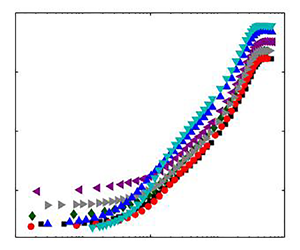Published online by Cambridge University Press: 08 April 2022

The effects of different geometries of two-dimensional (2-D) roughness elements in a zero pressure gradient (ZPG) turbulent boundary layer (TBL) on turbulence statistics and drag coefficient are assessed using single hot-wire anemometry. Three kinds of 2-D roughness are used: (i) circular rods with two different heights,  $k= 1.6$ and 2.4 mm, and five different streamwise spacing of
$k= 1.6$ and 2.4 mm, and five different streamwise spacing of  $s_{x}= 6k$ to
$s_{x}= 6k$ to  $24k$, (ii) three-dimensional (3-D) printed triangular ribs with heights of
$24k$, (ii) three-dimensional (3-D) printed triangular ribs with heights of  $k= 1.6$ mm and spacing of
$k= 1.6$ mm and spacing of  $s_{x}= 8k$ and (iii) computerized numerical control (CNC) machined sinewave surfaces with two different heights,
$s_{x}= 8k$ and (iii) computerized numerical control (CNC) machined sinewave surfaces with two different heights,  $k= 1.6$ and 2.4 mm, and spacing of
$k= 1.6$ and 2.4 mm, and spacing of  $s_{x}= 8k$. These roughnesses cover a wide range of ratios of the boundary layer thickness to the roughness height (
$s_{x}= 8k$. These roughnesses cover a wide range of ratios of the boundary layer thickness to the roughness height ( $23 < \delta /k < 41$), where
$23 < \delta /k < 41$), where  $\delta$ is the boundary layer thickness. All roughnesses cause a downward shift on the wall-unit normalised streamwise mean velocity profile when compared with the smooth wall profiles agreeing with the literature, with a maximum downward shift observed for
$\delta$ is the boundary layer thickness. All roughnesses cause a downward shift on the wall-unit normalised streamwise mean velocity profile when compared with the smooth wall profiles agreeing with the literature, with a maximum downward shift observed for  $s_{x}= 8k$. In the fully rough regime, the drag coefficient becomes independent of the Reynolds number. Changing the roughness height while maintaining the same spacing ratio
$s_{x}= 8k$. In the fully rough regime, the drag coefficient becomes independent of the Reynolds number. Changing the roughness height while maintaining the same spacing ratio  $s_{x}/k$ exhibits little influence on the drag coefficient in the fully rough regime. On the other hand, the effective slope
$s_{x}/k$ exhibits little influence on the drag coefficient in the fully rough regime. On the other hand, the effective slope  $(ES)$ and the height skewness
$(ES)$ and the height skewness  $(k_{sk})$ appear to be major surface roughness parameters that affect the drag coefficient. These parameters are used in a new expression for
$(k_{sk})$ appear to be major surface roughness parameters that affect the drag coefficient. These parameters are used in a new expression for  $k_{s}$, the equivalent sand grain roughness, developed for 2-D uniformly distributed roughness in the fully rough regime.
$k_{s}$, the equivalent sand grain roughness, developed for 2-D uniformly distributed roughness in the fully rough regime.